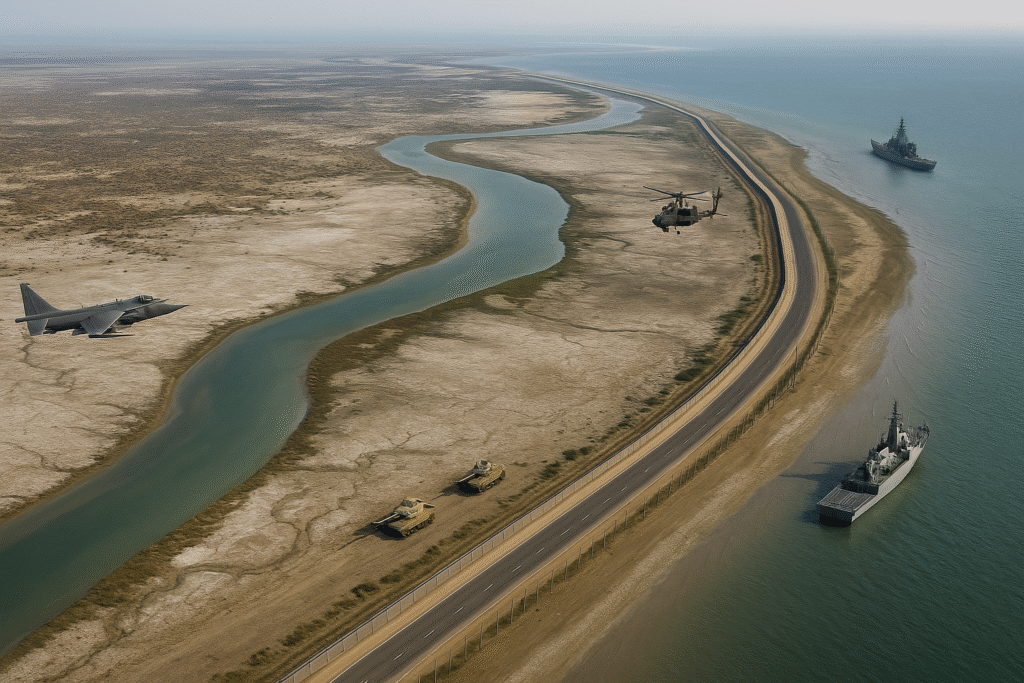New Delhi: The Rann of Kutch and Sir Creek regions have once again become the center of India–Pakistan border tensions, as India’s armed forces prepare to launch Exercise Trishul 2025 off the coast of Gujarat from October 30.
According to a Notice to Airmen (Notam) issued by India, the exercise will span parts of northwestern Gujarat and southern Rajasthan, continuing until November 10. The drill involves a tri-service mobilisation — with the Army, Navy, and Air Force joining forces in one of the largest coordinated exercises in recent years.
The Army has deployed a division equipped with tanks, armed helicopters, and missile units, while the Navy has stationed frigates and destroyers in the Arabian Sea. The Air Force has sent Su-30MKI and Rafale fighter jets to provide aerial cover and test integrated strike capabilities.
⚠️ Why the Rann of Kutch Is in Focus
The Rann of Kutch — a vast salt marsh the size of Kerala, straddling Gujarat and Pakistan’s Sindh province — has re-emerged as a potential flashpoint.
In May 2025, during Operation Sindoor, Pakistan allegedly shelled Indian positions near Sardar Post and Vigokot, and an Indian patrol shot down a Pakistani drone near the border.
The situation has since escalated. Speaking at the Bhuj military base on October 2, Defence Minister Rajnath Singh warned:
“Pakistan’s recent expansion of military infrastructure reveals its intentions. Any misadventure in Sir Creek will invite a response so strong it would change both history and geography.”
Intelligence reports indicate that Pakistan has established mini-cantonments and emergency airstrips near Sir Creek, interpreted by Indian agencies as an attempt to alter facts on the ground.
🌊 Sir Creek: A 96-km Dispute
The Sir Creek, a 96-kilometre tidal channel separating Gujarat from Sindh, holds immense strategic and economic significance. The creek’s ownership affects the maritime boundary and the Exclusive Economic Zones (EEZs) of both nations — which may contain oil, gas, and mineral reserves.
The dispute originates from differing interpretations of colonial-era maps:
- India argues for the Thalweg Principle — that the border should run along the mid-channel.
- Pakistan claims the boundary lies along the eastern bank, based on a 1914 Bombay Government Resolution.
Although the 1968 UN Tribunal awarded India around 90% of the Rann of Kutch, Sir Creek remained unresolved, with talks repeatedly failing — the last round taking place before the 2016 Uri terror attack froze dialogue.
🔥 Echoes of the 1965 Kutch Conflict
The current military buildup has drawn comparisons to Operation Desert Hawk (1965), when Pakistan launched incursions into the Kutch sector under Field Marshal Ayub Khan to test its Patton tanks and F-86 Sabre jets.
The skirmishes led to an UN-brokered ceasefire in July 1965, but within months, Pakistan escalated the conflict to Jammu & Kashmir, triggering the full-scale Indo-Pak War of 1965. The defeat cost Pakistan heavily, both militarily and economically.
🧭 Current Geopolitical Context
Pakistan’s Navy chief Admiral Naveed Ashraf recently visited forward posts near Sir Creek, vowing to defend “every inch of our maritime frontiers from Sir Creek to Jiwani.”
Indian defence sources view such rhetoric, coupled with the dry winter season ideal for military manoeuvres in the Rann, as an attempt at strategic distraction — possibly to divert India’s focus from Pakistan-occupied Kashmir (PoK).
As the Trishul 2025 exercises begin, the Rann of Kutch is once again transforming from a serene salt desert into a potential geopolitical chessboard, where the lessons of 1965 echo loudly across the white expanse.
Originally published on newsworldstime.com.
Originally published on 24×7-news.com.








